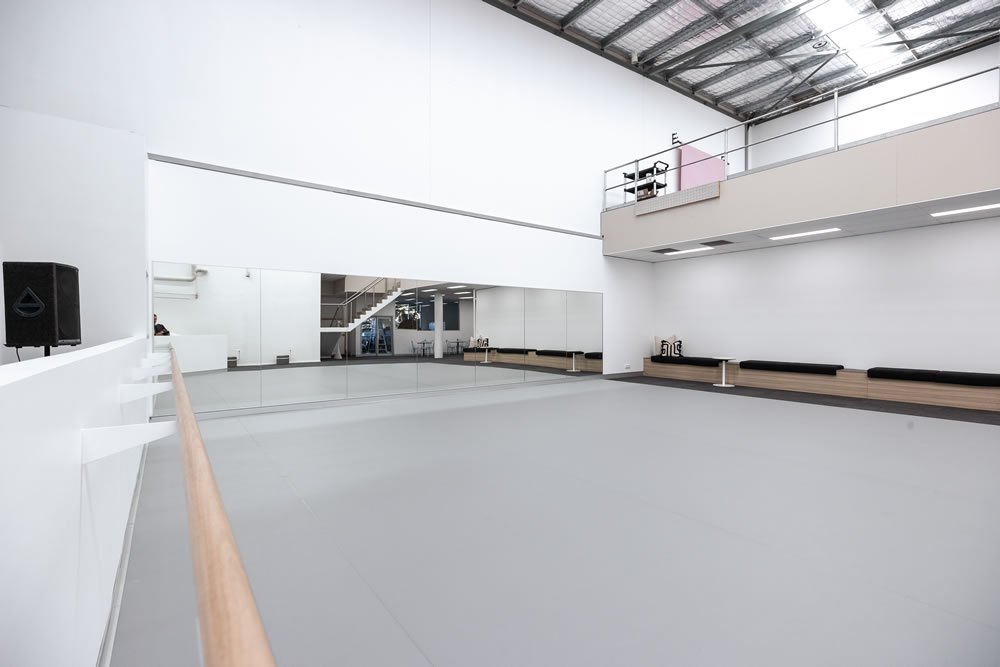A Sprung Floor is critical to any dance studio in order to protect the body of performers and teachers. In a perfect world, they should be specifically designed for dance (i.e. not a sprung sports floor, but more on that later). Dancing, teaching, and exercising on concrete floors or batten timber flooring will potentially cause injury, joint stress, pain and even irreversible damage to not only your feet and legs, but your entire body.
Ultimately, a dance space can be safe and functional without mirrors, without barres, and without curtains. But a dance space is not safe and fit for purpose without a sprung dance floor.
Things to consider:
- Trouble with engineered, hardwood and laminate flooring for dance
- Force reduction / shock absorption
- Difference between dance flooring and sports flooring
- Timber flooring for dance
- Types of footwear
Trouble with engineered, hardwood, and laminate flooring for dance
Engineered, hardwood and laminate flooring in their proprietary installation have not had a spectacular track record within the Australian dance community. The robust nature of dance with jumps and turns, generates greater movement in the boards than they are designed for.
The required level of deflection causes undue strain on the joining tongues of these systems often resulting in them breaking and the boards separating.
The European Standard EN 1904 is the closest thing to an international standard for dance floors. It indicates:

If the underlay is thick enough and soft enough to meet these standards then the propensity to pull apart or break with use is high and the resultant damage difficult to repair.
Force reduction / shock absorption
A suitable dance floor will have a shock absorption reduction value of at least 60%. The floor will absorb 60% of the downward force of landing, while the remaining 40% is absorbed by the landing muscles of performer. To explain this further, a concrete floor has a shock absorption value of 0%, leaving the full 100% shock of impact to affect the performer who is landing. You can see how this is not good for the bodies of dancers and teaching staff.
Sports floors vs Dance floors
Sports floors are unsuitable for performing arts spaces. They are much more rigid as sportspeople care about ‘ball bounce’ (how high a ball bounces). Having a floor with ‘ball bounce’ isn’t relevant to dancers. These rigid and stiff floors often have similar percentages of force reduction, but the vertical deformation is 1-2mm, rather than the 3-4mm of a dance floor. It is this rigidity that makes sports floors unsuitable for dance.
Wooden floors for dance
Most regular wooden floors as found in traditional scout halls and such are on a raised batten system with boards suspended over the top. These floors have adequate shock absorption, unless the timber boards are laid directly on top of a concrete or tile surface. Some types of batten timber floors are accepted for ballroom, folk and low impact social dance. However, there is always the risk of soft tissue damage (like splinters) or injury from panel unevenness and protruding nails. Wooden floors require regular and careful maintenance and most professional dancers (and cleaning staff) prefer a vinyl performance surface.
Footwear
Dance often occurs barefoot or with thin suede, leather, or satin soles. These shoes offer 0% force reduction to the dancer. Sports shoes provide a lot of the cushioning required to provide shock absorption. This is done with clever air pockets, engineered foams and gels. As dancers don’t have cushioning shoes, it is imperative the floor does that force reduction work.
A note about natural timber & bamboo in Australia…
Australia has an extreme range of temperatures and humidity levels through the year. If you choose a natural timber surface, there will be gaps in the cooler months and cupping in the warmer months. In some cases, there will be splitting as well. Consider the implications of this on a dance floor where performers will be barefoot, sliding, falling, and turning on an uneven surface.
It is the dance studio owners’ moral imperative and legal requirement to provide a safe workplace. Dancing on unsprung flooring is in direct opposition to those needs. The soul of the studio is the dance floor and should be the last thing to be weakened by budgetary forces. The best money you can spend in your dance space is on the floor – and better that than litigation down the track.


